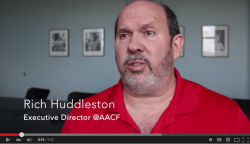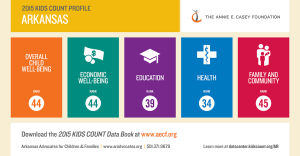
The 2015 KIDS COUNT® Data Book from the Annie E. Casey Foundation points out that more than 200,000 children are living in poverty in Arkansas. That’s almost 30 percent – close to one third – of all children in the state. The child poverty rate has gone up 4 percentage points since 2008, when the U.S. economy was in the midst of a recession. But there is good news. Arkansas is showing improvement in children’s health.
The 2015 Kids Count Data Book measures child well-being in four domains: economic well-being, education, health, and family and community. Today, the Casey Foundation reveals that the rising tide of recovery has left stagnant pockets of low-income, struggling communities and families. Arkansas dropped to 44th according to the latest data. The state was ranked 41st a year ago.
See the entire Kids Count Data Book here.
You can see the Arkansas-specific data here.
Twenty nine percent of Arkansas children live in poverty. The national average is 22 percent. Arkansas also lost ground in the education rankings. Fifty five percent of Arkansas children are not enrolled in any type of pre-K program. That’s up from 53 percent a year ago. The state gave pre-K programs a $3 million funding bump last legislative session after ignoring the program’s growing need for eight years. The Data Book lists early childhood education as a possible solution to some of the problems outlined in the report.
One area where the state does very well is health coverage for kids. Only six percent of Arkansas children do not have health insurance, due mostly to the state’s Medicaid program known as ARKids First.
“We have, as a state, made a very concerted effort on kids’ health going back to the late 90s,” says Rich Huddleston, executive director at Arkansas Advocates for Children and Families. “In fact, this is an area where ARKids has been so effective in covering kids that we may not see that number move for a while. This just shows you what can happen when we truly invest in the future of our children. Arkansas can be a national leader in this area. I think, and the report concludes this as well, that we need to put this kind of effort into pre-K. That’s an area where we can really make some improvements.”
For the first time in a decade, a non-New England state ranks number one for overall child well-being. Minnesota holds the top spot, followed by New Hampshire, Massachusetts, Iowa, and Vermont. Arizona, Nevada, Louisiana, New Mexico and Mississippi rank lowest.
According to the report, too many minority children are on the brink of poverty in Arkansas. The economy is showing signs of recovery for some, but not for African American, Latino and American Indian children. There is a widening gap that is leaving children of color behind.
“The stark reality is that millions of children, particularly African Americans, Latinos, and American Indians live on the precipice of poverty,” says Laura Speer, associate director for policy reform and advocacy at the Annie E. Casey Foundation. “Today, as the economy recovers, we see a widening gap between the living standards of many children of color and other kids. The good news is when we’ve invested in the right strategies and policies – like ARKids First in Arkansas – we have made a difference for kids.”
Child poverty won’t be an easy problem to tackle. The Casey Foundation offers a number of recommendations in the report to make good on the American promise of opportunity for all children. The Foundation promotes a two-generation strategy that simultaneously addresses the needs of children directly while providing tools and resources to their parents. Three critical strategies include:
- Provide parents with multiple pathways to get family-supporting jobs and achieve financial stability.
- Ensure access to high-quality early childhood education and enriching elementary school experiences.
- Equip parents to better support their children socially and emotionally and to advocate for their kids’ education.


